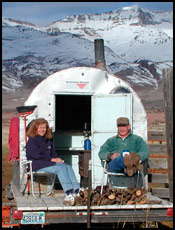
Ron Torell with his wife, Jackie.
Cow Camp Chatter
Bull power
A Holstein bull by the name of Potter recently joined a small, but elite, group of dairy sires that have produced and sold more than 1 million units of semen. This elite group of bulls could be titled the "Bulls of the Century." Their genes roam herds around the globe. Some estimate a million-unit bull would have more than 150,000 daughters and 2.3 million granddaughters and would be responsible for 15% of the DNA in today's U.S. dairy herd.
The U.S. beef industry maintains a wide variation in its genetic pool, with several breeds of cattle being utilized. Grass is harvested by our four-legged employees from the arid rangelands of the West to the lush grasslands of the East and the hot, humid areas of the South.
Conversely, most of the nation's dairy cows are confinement-fed. Meals are delivered to them in a balanced, total mixed ration (TMR). For this reason, the dairy industry can single-trait select and maintain a tight genetic base.
The beef industry will never have the tight genetic base that is seen in the dairy industry. In order to maintain reproductive success with limited feed resources, beef cows in arid climates are generally smaller-framed, lower in milk production and hardy. Missed income opportunity would result if this type of cow were used on more lush grasslands where perhaps a larger-framed, higher-milking cow could be reproductively successful.
Advantage in uniformity
Many feedlot operators prefer to feed Holstein steers vs. beef breeds because of the tight genetic makeup of the breed. They know what to expect for feed conversions, average daily gain, days on feed, breakeven, percent Choice, yield grades, etc.
Holstein steers perform at a lower level than beef animals, but they are consistent. The lower performance is factored into the purchase price with confidence and accuracy. Because of this predictability, fewer pens of Holstein steers close out in the red than pens of beef cattle.
Beef steers are all over the board in performance, primarily due to genetic makeup — even within a breed. Unpredictable best sums it up for beef cattle.
Narrower focus
Only 5%-7% of the nation's beef herds are bred by artificial insemination (AI). Many of these AI-bred cows are registered seedstock, with the bull offspring going to the commercial cattleman.
More than 90% of dairy cattle are AIed, with their female offspring going into commercial production. The bulls used for AI are selected primarily for the single trait of milk production and mammary system structure to support added milk production. Dairy cows remain in production fewer years than beef cows. Generations are turned more quickly, accelerating genetic improvement.
This is the difference in the tremendous progress the dairy cow has made in the single trait of milk vs. the slow progress the beef cow has made in multiple and low-heritability traits. Just as the dairy industry is producing more milk with fewer cows, the beef industry is producing more pounds of beef with fewer brood cows. These similarities can be attributed to improved genetics and management practices.
Don Trimmer, director of beef programs for Accelerated Genetics, agrees with the wide variability of beef cattle compared to the dairy industry. He points out that the number of beef breeds making an impact is substantially lower than it was 10 years ago.
The American Angus Association registers more cattle than all other breeds combined. The dominance of Angus genetics in the commercial cow herd has helped to reduce some of the variation in the nation's beef cow herd, though it may be more from a phenotypic standpoint. In many areas of the country, the "rainbow" herds of the past are no longer found. The majority are solid black or red cows with some baldies.
If you look at the data of most widely used breeds, it continues to show 60%-70% Angus or Angus-cross bulls. The volume of semen sold on beef bulls like EXT, New Design 036, Traveler and Focus has had a huge effect on the genetics of the commercial cow herd.
Experts agree that the dairy industry may be on the verge of being inbred, yet they point out that the dairy industry may hold the key to decoding the bovine genome. Million-unit bulls such as Potter are genetic landslides for this decoding process because they appear in so many pedigrees. Their family tree serves as a guide and base in identifying the most important genes, an ultimate reference point for DNA technology.
 Beef cattle genetic advancement in the area of uniformity and predictability has and will continue to move at a slower pace than what the dairy industry has been able to accomplish. This should not discourage the beef industry from working toward the goal of producing uniform and predictable cattle. This can be achieved by incorporating quality, registered bulls into breeding programs and by using, when applicable, technology such as AI selecting bulls with high-accuracy expected progeny differences (EPDs) for multiple traits.
Beef cattle genetic advancement in the area of uniformity and predictability has and will continue to move at a slower pace than what the dairy industry has been able to accomplish. This should not discourage the beef industry from working toward the goal of producing uniform and predictable cattle. This can be achieved by incorporating quality, registered bulls into breeding programs and by using, when applicable, technology such as AI selecting bulls with high-accuracy expected progeny differences (EPDs) for multiple traits.
As always, if you would like to discuss this article or simply want to talk cows, do not hesitate to contact me at 775-385-7665 or by e-mail.
[Click here to go to the top of the page.]




